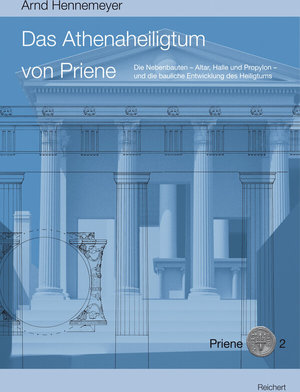
Das Athenaheiligtum von Priene
Die Nebenbauten – Altar, Halle und Propylon – und die bauliche Entwicklung des Heiligtums
von Arnd Hennemeyer
Das Athenaheiligtum der Stadt Priene mit seinem umfangreichen Bestand an Architekturresten war durch Forschungsunternehmungen im 19. Jahrhundert bis auf das Niveau hellenistischer Zeit freigelegt worden. Dies ermöglichte, eine Untersuchung des Komplexes weitgehend mit den Methoden der Bauforschung durchzuführen, ergänzt um einige gezielte archäologische Sondagen. Der Band, der die Ergebnisse dieser mehrjährigen Feldforschung vorlegt, basiert auf einer 2006 an der TU München angenommenen Dissertation. Gegenstand des vorliegenden Bandes sind drei Bauten des Heiligtums – in der zeitlichen Reihenfolge ihrer Errichtung der Monumentalaltar, die Halle und das Propylon – und schließlich die Gesamtanlage des Heiligtums. Zur Architektur des Hauptbaus – des von Pytheos entworfenen Athenatempels – folgt eine eigene Monographie von Wolf Koenigs.
Die umfassende und detaillierte zeichnerische Dokumentation der in situ erhaltenen Reste und aller zuweisbaren Bauteile, ergänzt durch Notizen, Skizzen und Fotos aus dem 19. Jahrhundert, kann die für die drei Bauten entwickelten Rekonstruktionen fast lückenlos belegen. Das führt teils zu Bestätigung und Präzisierung älterer Rekonstruktionsvorschläge,
oft aber auch zu wichtigen Änderungen. Gezielt beobachtet werden Hinweise auf die Bauabfolge, die technische Ausführung, Umplanungen während des Bauprozesses, Bauphasen und spätere Umbauten. Die Analyse der einzelnen Bauten verfolgt unterschiedlichste Aspekte, die mitunter weit über die Einzelobjekte hinausweisen:
Entwurfs- und Planungsprozesse, die Proportionierung der Bauten und ihrer Bauglieder,
Metrologie und das verwendete Fußmaß, die Mittel architektonischer Verfeinerung, die Beziehung zwischen Funktion und Gestalt der Bauten, Blickbeziehungen innerhalb des Heiligtums und in die Ferne, Vergleiche mit Angaben Vitruvs, sowie im Zusammenhang mit dem Propylon die Entwicklung korinthischer Kapitelle hellenistischer Zeit in Kleinasien und im Zusammenhang mit dem Altar die Merkmale von Halbsäulenordnungen.
Die Ergebnisse zu den Einzelbauten werden abschließend zusammengeführt, um die bauliche Entwicklung des Heiligtums im Ganzen zu rekonstruieren, die sich vom Baubeginn des Tempels im 4. Jh. v. Chr. bis zur Errichtung des Propylons, wahrscheinlich in augusteischer Zeit, erstreckte. Dieser monumentale Ausbau des Heiligtums folgte keineswegs einem bereits von Beginn an festgelegten Gesamtplan. Vielmehr nahm das Heiligtum ursprünglich sogar eine weit kleinere Fläche, als bislang angenommen, ein, ehe es schrittweise, zuletzt im 1. Jh. v. Chr., erweitert wurde. Die einzelnen Bauprojekte änderten die Erscheinung und Anlage des Heiligtums jeweils entscheidend und spiegeln unterschiedliche städtebauliche Vorstellungen wider. Die Publikation erschließt die Architektur des Athenaheiligtums für unterschiedliche Disziplinen der Altertumswissenschaften und dient als Referenzwerk für Forschungen zu hellenistischer Architektur.
Already during the 19th century, the sanctuary of Athena at Priene was excavated down to its Hellenistic levels. These early excavations exposed the entire site and brought to light a large number of architectural fragments. This book presents a new examination of the sanctuary’s architecture; it relies on the results of several years of field research, and it is the result of the author’s doctoral work at the Technical University of Munich (dissertation submitted in 2006). Primarily, this book relies on the methods of historical building research (Bauforschung), but it also includes the results of new archæological excavations carried out by others. The focus of the book is on three specific structures of the sanctuary, which include (in chronological order of construction) the monumental altar, the stoa, and the propylon; an assessment of the entire sanctuary concludes the book. In a separate monograph of the same series, Wolf Koenigs will publish the architecture of the sanctuary’s main building, the temple of Athena, which was designed by the famous architect Pytheus.
This book offers a new and nearly complete architectural reconstruction of the sanctuary’s altar, stoa, and propylon. The evidence for this is twofold: first, a comprehensive and detailed architectural documentation of both the fragments surviving in situ and all other architectural members that can arguably be attributed to the different buildings; and second, the notes, sketches and photographs of the 19th century-researchers. A synthetic analysis of this data confirms and specifies older reconstructions. Moreover, it leads to entirely new insights on specific issues such as the construction process and its technical implementation, design changes during construction, construction phases, and later modifications. The analysis of the three structures also pays attention to aspects that are far beyond the individual object: processes of design and planning; the proportions of the buildings and their parts; metrology and the applied foot lengths; architectural refinements; the relation between the function and the appearance of the buildings; internal and external sight lines; comparisons with statements of Vitruvius; the development of Corinthian capitals in Hellenistic Asia Minor; and the specific characteristics of engaged columns.
Finally, the individual results are brought together to assess the structural development of the entire sanctuary, from the construction of the temple during the 4th century BC to the propylon, which is probably of Augustan date. As it turns out, the sanctuary’s monumental expansion did not follow a fixed master plan. Contrary to previous assumptions, it originally covered a relatively small area, which was gradually expanded until the 1st century BC. With each building project, the appearance and the layout of the sanctuary changed significantly; each construction phase reflects different conceptions of urban planning. This publication makes the architecture of the sanctuary of Athena accessible for various disciplines of classical studies, and it serves as a reference work for research on Hellenistic architecture.






